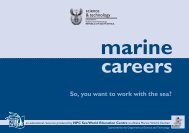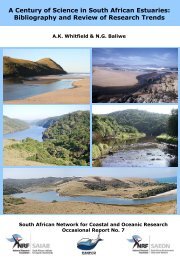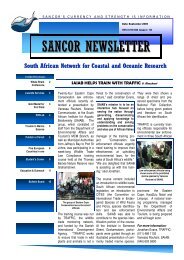SANCOR Newsletter -200 - Sancor home page - National Research ...
SANCOR Newsletter -200 - Sancor home page - National Research ...
SANCOR Newsletter -200 - Sancor home page - National Research ...
You also want an ePaper? Increase the reach of your titles
YUMPU automatically turns print PDFs into web optimized ePapers that Google loves.
Page 13<strong>SANCOR</strong> NEWSLETTER #<strong>200</strong>Dolphin pathology project—how healthy are our dolphins really?By Stephanie Plön 1,2 and Emily Lane 31South African Institute for Aquatic Biodiversity(SAIAB); 2 Bayworld; 3 <strong>National</strong> Zoological Gardensof South AfricaIt reads like a scene from a science ficonthriller: first about 900 dolphins and porpoiseswashed up dead on the beach, then almostas many pelicans. The sciensts werepuzzled—no‐one really knew what was causingthe mass die‐off ‐ and speculaons aboutthe possible reasons ranged from acousctrauma caused by seismic exploraon to avirus affecng both birds and mammalsalike.Unfortunately it is not a science ficon novel,but a harsh reality that recently playedout along Peru's North Pacific coastline. Suchincidences have to date only been knownfrom the Northern Hemisphere, such as theseal and dolphin die‐ offs from the North Seaand Mediterranean in the 1980's and early<strong>200</strong>0’s, which were caused by Phocine distempervirus and a previously unknown morbillivirus(the morbilliviruses are a group ofviruses including the human measles andcanine distemper viruses).To date we have been lucky here in SouthAfrica as we have not seen any such majordie‐offs involving marine mammals off ourcoastline. Although we record and expectlow levels of disease in wild populaons as anatural occurrence, it was surprising thenthat the same pathological changes visiblewith the naked eye were evident in almostall dolphins dissected during roune necropsiesat the KwaZulu‐Natal Sharks board in<strong>200</strong>9. Between 20 and 25 dolphins drown inthe shark nets off KwaZulu‐Natal every yearand since the early 1980’s sciensts from thePort Elizabeth Museum have made use ofthe opportunity to dissect these unfortunateanimals and to accession data and samplesfrom them to the Graham Ross MarineMammal collecon at the museum for themto be available for research purposes. Pastand present studies on these samples includeresearch on the morp<strong>home</strong>trics, genecs,life history parameters, and diet ofthese animals.But <strong>200</strong>9 proved to be an unusual year asalmost all animals showed signs of someabnormalies on major organs, such as numerousblisters on the lining of the organsand in the abdominal cavity. What was goingon?Us tradionally trained marine biologistsunfortunately learn very lile about diseasesin the marine environment, so I knew I hadto seek expert input. Luckily someone suggestedthat I enlist the assistance of thepathologist at the Naonal Zoological Gardensof South Africa in Pretoria, Dr. EmilyLane. And fortunately Emily did not shy awayfrom such an excing new challenge either,since she knew all about land criers of allsorts, but had unl then had very lile exposureto marine animals. Jointly we set out totry and elucidate what was going on and,together with German colleagues trained inthe very specialized field of marine mammalpathology (Drs. Peter Wohlsein and UrsulaSiebert, both from the VeterinaryUniversity, Hannover,Germany), a collaborave researchproject supported bythe NRF and the DFG (its Germanequivalent) was iniatedin 2010 to invesgate the generalhealth, including thepathological changes we hadobserved, of the dolphins incidentallycaught in the sharknets off KwaZulu‐Natal.Marine mammals in generaland parcularly coastal speciesare increasingly used as indicatorspecies of marine environmentalhealth as they can besennels for human healthwhere humans are using thesame coastal environment.Most of the dolphins caught inthe shark nets are either IndianOcean bolenose dolphins(Tursiops aduncus) or Indo‐Pacific humpback dolphins(Sousa chinensis), both coastal species, andthus potenally prone to a number of anthropogenicimpacts on their health, rangingfrom disturbance due to coastal developmentsto polluon from agricultural run‐offand sewage outlets. However, we know verylile about the general health status of theseanimals‐some baseline studies on the generalbiology of these two species from Kwa‐Zulu‐Natal exist due to previous studies onspecimens from the shark nets, but lile iscurrently known on how the changing marineenvironment affects the lifestyle, populaondynamics, and health of these species.However, increasing evidence emerges elsewherein the world that supports a link betweenhuman environmental disturbanceand emerging infecous diseases of wildlifepopulaons. It is becoming clear that anthropogenicenvironmental changes may promotethe emergence of pathogens throughtransportaon and introducon of infecousagents or hosts to new environments,through the manipulaon of local ecosys‐Morne de Wet (University of Pretoria, Onderstepoort),Ursula Siebert (Veterinary University ofHannover, Germany) and Stephanie Plön (SAIAB/Bayworld) during necropsies at the KwaZulu-NatalSharks Board.







